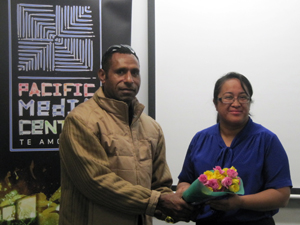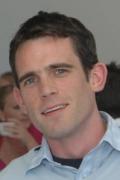
AUCKLAND (Pacific Media Watch): Iulia Leilua’s familiar face on Māori Television’s Native Affairs current affairs programme represents an enviable cultural mix.
Her love for the media began in her Taumarunui home where her Samoan father would import newspapers from Apia and they would listen to the first radio broadcasts in New Zealand in Te Reo.
Her Māori mother (Ngati Haua, Ngati Hekeawai) had her schooled at St Joseph’s Māori Girls College and not long after graduating, she found her way to Television New Zealand.
Now, it’s been more than a decade since Leilua and TVNZ’s Sandra Kailahi sat down in the TVNZ cafeteria one day and dreamed of what would become the Pacific Islands Media Association.
They were penniless, and Leilua says the PIMA books haven’t changed much since then.
“In the 10 years that PIMA has been together sure we haven’t had much money,” she says.
“But it’s a big thing to keep going for 10 years.”
Destined for great things
Speaking at a Pacific Media Centre seminar at AUT University, Leilua reflected on the early days.
“We knew we were destined for greater things – you have to think like that,” she says.
“We actually came to AUT and asked if we could hold our conference here. We brought David Robie down from the University of the South Pacific in Fiji and Kalafi Moala from Tonga as well.”
Ten years later, and after almost-annual conferences, there are a few more Pacific faces in the New Zealand media.
Leilua recently attended a trivia night organised by her organisation and was heartened to see no less than five Pacific cameramen. She remembered when there was one in the whole of the country - and here were five, just in Auckland.
But for Leilua, it’s nowhere near enough.
“By 2020, 20 percent of New Zealanders will be of Pacific descent,” she says. “So it stands to reason that come 2020 you’d think one fifth of the New Zealand media would be brown.”
Getting Pacific issues on the agenda
Apart from encouraging more Pacific people into the media, PIMA aims to rally to get journalists and media organisations to report more on Pacific issues to ensure Pacific Islanders get news about themselves.
“We should be reaching out to the Pacific region,” she says. “There are amazing people telling amazing stories and they often don’t get told.”
“We also want to have more positive stories and counter negative stereotypes,” she says.
But the barriers are always the same – a lack of funding, jobs, and Pacific Islanders being “wrapped up” with other ethnic minorities.
Still, Leilua is hopeful that funding can be found.
After all, PIMA has been campaigning for years for the long-awaited Pasifika television channel.
“Who says we need to rely on New Zealand on Air and the government for funding? There is enough good will around the Pacific people to do it.”
Reality nearing
Leilua says there is enough content already for a 24/7 Pasifika television channel, and it might not be far away from reality.
As well as telling the stories of New Zealand-based Pasifika people, connecting with people in the Pacific is crucial to the success of such a venture.
But dealing with the other Pacific media associations has not been plain sailing.
“There is a lot of competitiveness among Pasifika in media in the region and a lot of distrust,” she says.
“A lot of history has gone under the bridge.”
Leilua says it has been difficult to engage with colleagues in the Pacific as the New Zealand media is not seen as being "genuinely Pacific".
“We weren’t able to become full members of PINA (Suva-based Pacific Islands News Association) because under the PINA constitution, New Zealand is not a Pacific country.”
Greater hope
However, she says recent developments give her greater hope. She recently attended a media workshop in Apia, Samoa, where the newest network group was formed – the Media Alliance of the Pacific – and this time she was welcomed into the fold.
“We went to put our stake in the ground,” she says of her efforts to try again.
She says MAP is not just another media group to add to the long and growing list.
“It wasn’t to replicate PINA, PasiMA or anything else, but to develop a new strategy for the Pacific.”
“What I liked was that everyone was open-minded and the majority were women.”
But there is still a long way to go for collegiality and effectively working together.
“It’s hard because everyone expects you to take sides – if you engage with PasiMA, they assume that you are against PINA,” she says.
“We don’t have the luxury of taking sides down here – we need all the help we can get.”
Leilua praises PINA for its recent workshop in Auckland before the Pacific Islands Forum and says it was great to be able to network with them.
Different view
She also has great hopes that the Pacific journalists themselves learnt a lot about New Zealand.
“Those from the Pacific who came for the forum were blown away by New Zealand and went away thinking very differently,” she says.
Apart from the networking issues, there are plenty of other cultural mores that a reporter in her situation needs to keep in mind.
Toeing the line between respect and demanding answers in the public interest have got more than one journalist in hot water in the past.
With her reporting on Native Affairs she admits: “Sometimes you find yourself skirting around the issues because it’s hard to ask the hard questions.”
But she is not afraid of holding back.
“Let’s go for our Māori leaders more – let’s not just go for our Pacific leaders, where it is easier because they are out there and we don’t know them closely.”
Leilua says sometimes the cultural challenge is “what to say, what not to say, or what not to sing in a waiata”.
But it’s the culture itself that teaches the best lessons.
Poignant story
Leilua tells the poignant story of a recent funeral of a Māori family member, where she received the unenviable task of cleaning the marae bathrooms.
“At first I was a bit put off, thinking: ‘Hey I’m a Native Affairs reporter’, but I realised there is a point to it all,” she says.
While it was a different sort of ‘dirty work’ for a journalist, it encouraged attendants at the funeral to use the bathrooms and as a result, eat and drink more and have a good time.
Most importantly, it taught her a lot about humility.
“And it sounds strange, but it taught me leadership more than anything else.”
It’s that leadership that will take PIMA into its second decade, and while Leilua is putting bread on the table with her reporting, there are plenty of other hats for her to wear.
She also runs her own public relations company, Silk Associates, and maintains an online directory for Māori, Pasifika and indigenous media personnel – Brown Pages.
It’s no surprise that Leilua has done well in the media, and she finds it puzzling that more Pacific Islanders don’t give it a go. For those starting out, Leilua puts it all in perspective with regard to PIMA.
“We had notions of grandeur, but since then we have had to scale it back. But there is plenty of passion and we will keep it going.”
A dinner will mark the first decade of PIMA's role as an advocate for Pacific Islands media people at the Manhattan Clubrooms, Mt Roskill, on November 2. More information.
(cc) Creative Commons



